小学英语动词to do、动词ing和动词原形的用法总结及运用技巧
- 格式:docx
- 大小:18.58 KB
- 文档页数:4
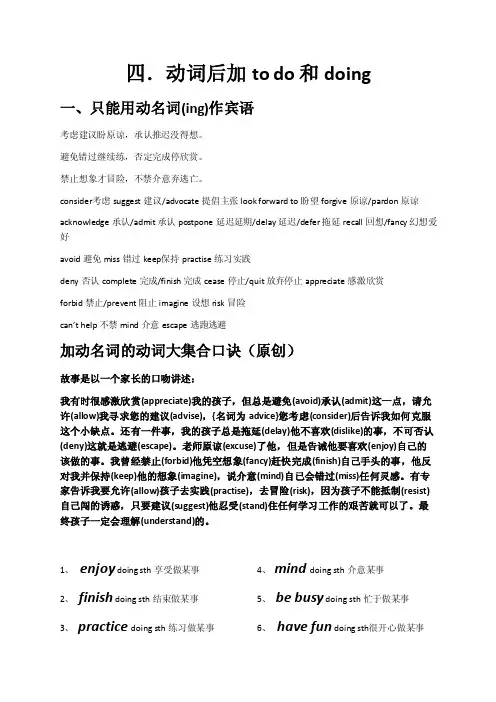
四.动词后加todo 和 doi ng一、只能用动名词(ing)作宾语考虑建议盼原谅,承认推迟没得想。
避免错过继续练,否定完成停欣赏。
禁止想象才冒险,不禁介意弃逃亡。
c onsider考虑suggest建议/advoc ate 提倡主张look for ward to盼望forgiv e原谅/pard on 原谅ac knowledg e承认/admi t 承认post pone延迟延期/delay 延迟/defer拖延recall回想/fancy幻想爱好av oid避免mis s错过keep保持practis e练习实践de ny否认comp lete完成/f inish 完成cease停止/quit 放弃停止appreci ate感激欣赏forbid禁止/prevent阻止imagi ne设想risk冒险can’t help 不禁mind介意es cape逃跑逃避加动名词的动词大集合口诀(原创)故事是以一个家长的口吻讲述:我有时很感激欣赏(appr eciate)我的孩子,但总是避免(avoid)承认(admit)这一点,请允许(allow)我寻求您的建议(a dvise),{名词为advic e}您考虑(co nsider)后告诉我如何克服这个小缺点。
还有一件事,我的孩子总是拖延(dela y)他不喜欢(d islike)的事,不可否认(d eny)这就是逃避(escape)。
老师原谅(e xcuse)了他,但是告诫他要喜欢(enjoy)自己的该做的事。
我曾经禁止(fo rbid)他凭空想象(fancy)赶快完成(fi nish)自己手头的事,他反对我并保持(keep)他的想象(im agine),说介意(mind)自已会错过(mi ss)任何灵感。
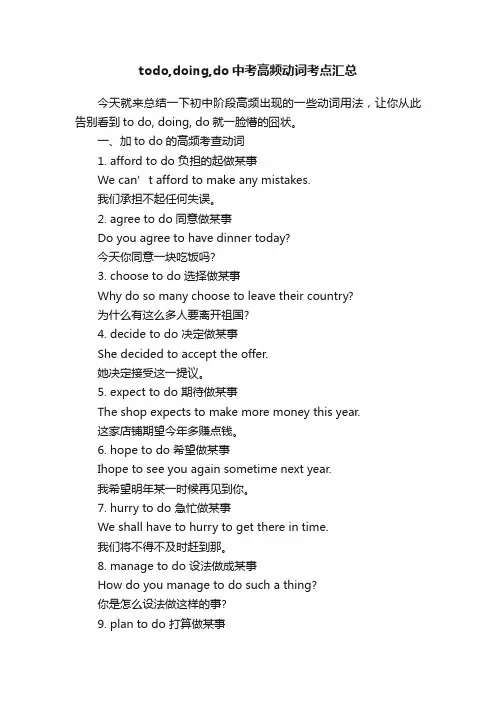
todo,doing,do中考高频动词考点汇总今天就来总结一下初中阶段高频出现的一些动词用法,让你从此告别看到to do, doing, do就一脸懵的囧状。
一、加to do的高频考查动词1. afford to do 负担的起做某事We can’t afford to make any mistakes.我们承担不起任何失误。
2. agree to do同意做某事Do you agree to have dinner today?今天你同意一块吃饭吗?3. choose to do 选择做某事Why do so many choose to leave their country?为什么有这么多人要离开祖国?4. decide to do 决定做某事She decided to accept the offer.她决定接受这一提议。
5. expect to do 期待做某事The shop expects to make more money this year.这家店铺期望今年多赚点钱。
6. hope to do 希望做某事Ihope to see you again sometime next year.我希望明年某一时候再见到你。
7. hurry to do 急忙做某事We shall have to hurry to get there in time.我们将不得不及时赶到那。
8. manage to do 设法做成某事How do you manage to do such a thing?你是怎么设法做这样的事?9. plan to do 打算做某事Where do you plan to spend your holiday?你打算去哪里度假?10. prefer to do 宁愿做某事Iprefer to travel in the front of the car.我宁愿坐在汽车的前面。
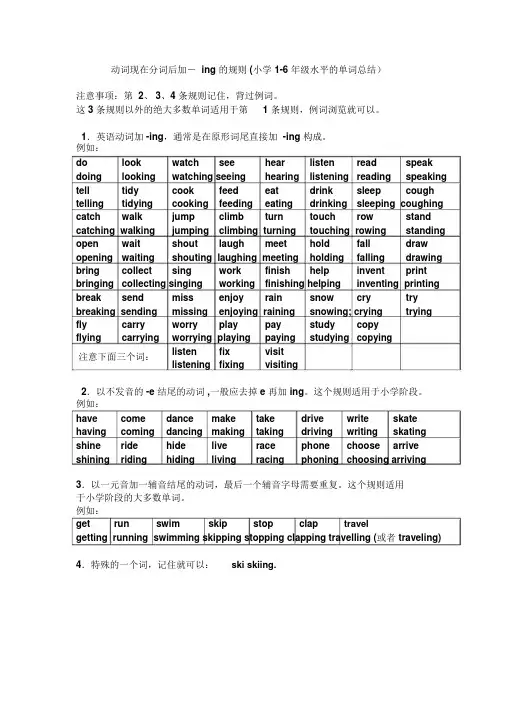
动词现在分词后加- ing 的规则 (小学 1-6 年级水平的单词总结)注意事项:第 2、 3、4 条规则记住,背过例词。
这 3 条规则以外的绝大多数单词适用于第 1 条规则,例词浏览就可以。
1.英语动词加 -ing,通常是在原形词尾直接加 -ing 构成。
例如:do look watch see hear listen read speak doing looking watching seeing hearing listening reading speaking tell tidy cook feed eat drink sleep cough telling tidying cooking feeding eating drinking sleeping coughing catch walk jump climb turn touch row stand catching walking jumping climbing turning touching rowing standing open wait shout laugh meet hold fall draw opening waiting shouting laughing meeting holding falling drawing bring collect sing work finish help invent print bringing collecting singing working finishing helping inventing printing break send miss enjoy rain snow cry try breaking sending missing enjoying raining snowing; crying tryingfly carry worry play pay study copyflying carrying worrying playing paying studying copying注意下面三个词:listen fix visit listening fixing visiting2.以不发音的 -e 结尾的动词 ,一般应去掉 e 再加 ing。

动词todo和doing总结和口诀哎哟喂,说起这个动词的“todo”和“doing”,咱们四川人得整点接地气的说法,不然咋个能感受到那份细腻和独特呢?来来来,咱们就像坐茶馆头摆龙门阵一样,好好聊聊这个。
你晓得不,动词这个东西,在咱们生活中那是活蹦乱跳的,跟咱四川的火锅一样,热气腾腾,味儿十足。
说到“todo”和“doing”,我就想起小时候学骑车,那时候心里头想的全是“我要学会骑车”(todo),那股子劲儿,就像心里头有把火,烧得你非要达成目标不可。
但真正骑上车,那轮子一转,就变成了“正在骑车”(doing),感觉风从耳边过,自由得很,又稳当又带劲儿。
咱们四川话里头有个词儿,叫“想头”和“搞头”,我觉得跟这“todo”和“doing”还挺搭的。
心里头有个“想头”,那就是你的目标,你的“todo list”,比如说明天要去爬山,心里就那个激动啊,晚上都睡不着觉,满脑子都是“我要爬山去”(todo)。
但真到了第二天,穿上鞋,背上包,一脚一脚往山上蹬的时候,那就是“搞头”来了,也就是你的“doing”时刻。
这时候,你会发现,沿途的风景,呼吸的空气,还有那份成就感,都是那么真实,那么让人陶醉。
再给你说个口诀,好记又好玩:“心头有个想头儿,脚下就有搞头儿。
todo是梦开始的地方,doing是让梦照进现实的阳光。
”你看,这样一来,是不是就跟咱们四川人的生活哲学对上了?做事情嘛,先要想得美,然后脚踏实地一步步去整,啥子难题都不怕!所以嘛,不管是学习、工作还是生活,咱们都得有这样的心态。
心里有个“todo”,手上就有不停的“doing”。
这样,日子才能过得有滋有味,像咱们四川的麻辣烫一样,热辣辣、香喷喷,让人回味无穷!。

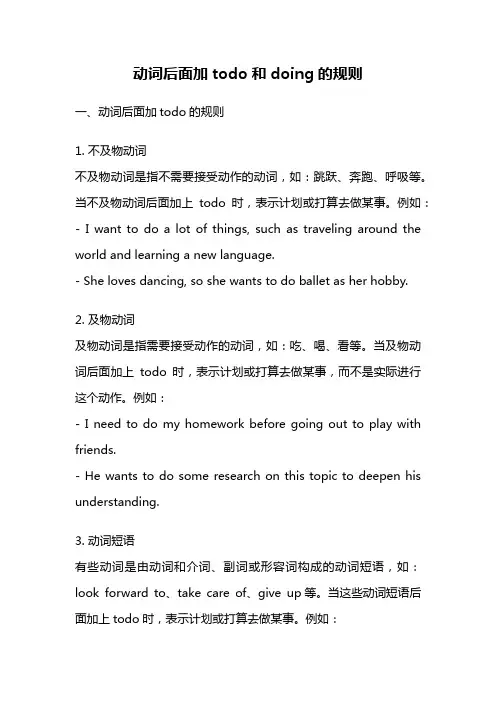
动词后面加todo和doing的规则一、动词后面加todo的规则1. 不及物动词不及物动词是指不需要接受动作的动词,如:跳跃、奔跑、呼吸等。
当不及物动词后面加上todo时,表示计划或打算去做某事。
例如:- I want to do a lot of things, such as traveling around the world and learning a new language.- She loves dancing, so she wants to do ballet as her hobby.2. 及物动词及物动词是指需要接受动作的动词,如:吃、喝、看等。
当及物动词后面加上todo时,表示计划或打算去做某事,而不是实际进行这个动作。
例如:- I need to do my homework before going out to play with friends.- He wants to do some research on this topic to deepen his understanding.3. 动词短语有些动词是由动词和介词、副词或形容词构成的动词短语,如:look forward to、take care of、give up等。
当这些动词短语后面加上todo时,表示计划或打算去做某事。
例如:- She is looking forward to doing some shopping during the holiday.- They should take care of their health by doing exercise regularly.二、动词后面加doing的规则1. 不及物动词不及物动词后面加上doing表示正在进行某个动作。
例如:- She is swimming in the pool now.- They are playing basketball in the park.2. 及物动词及物动词后面加上doing表示正在进行某个动作,并且这个动作有对象。
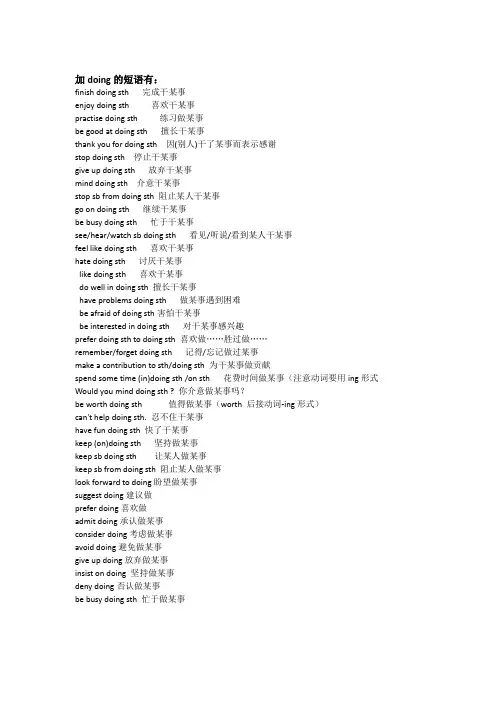
加doing的短语有:finish doing sth 完成干某事enjoy doing sth 喜欢干某事practise doing sth 练习做某事be good at doing sth 擅长干某事thank you for doing sth 因(别人)干了某事而表示感谢stop doing sth 停止干某事give up doing sth 放弃干某事mind doing sth 介意干某事stop sb from doing sth 阻止某人干某事go on doing sth 继续干某事be busy doing sth 忙于干某事see/hear/watch sb doing sth 看见/听说/看到某人干某事feel like doing sth 喜欢干某事hate doing sth 讨厌干某事like doing sth 喜欢干某事do well in doing sth 擅长干某事have problems doing sth 做某事遇到困难be afraid of doing sth害怕干某事be interested in doing sth 对干某事感兴趣prefer doing sth to doing sth 喜欢做……胜过做……remember/forget doing sth 记得/忘记做过某事make a contribution to sth/doing sth 为干某事做贡献spend some time (in)doing sth /on sth 花费时间做某事(注意动词要用ing形式Would you mind doing sth ? 你介意做某事吗?be worth doing sth 值得做某事(worth 后接动词-ing形式)can't help doing sth. 忍不住干某事have fun doing sth 快了干某事keep (on)doing sth 坚持做某事keep sb doing sth 让某人做某事keep sb from doing sth 阻止某人做某事look forward to doing盼望做某事suggest doing建议做prefer doing喜欢做admit doing承认做某事consider doing考虑做某事avoid doing避免做某事give up doing放弃做某事insist on doing 坚持做某事deny doing否认做某事be busy doing sth 忙于做某事加动词原形的有:make sb do sth 让某人做某事see sb do sth 看到某人做某事hear sb do sth 听到某人做某事listen to sb to do sth 听某人做某事watch sb do sth 看某人做某事notice sb do sth注意到某人做某事let sb do sth 让某人做某事have sb do sth让/使某人做某事help sb do sth帮助某人做某事后面接to do 的有很多,除去上面的动词外,基本上是接动词不定式的。
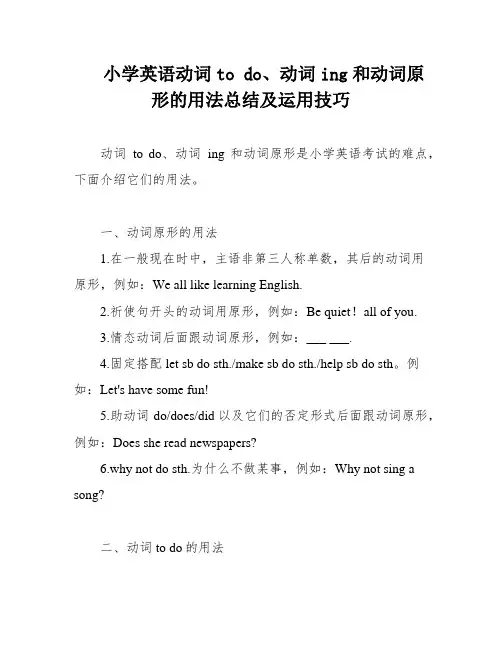
小学英语动词to do、动词ing和动词原形的用法总结及运用技巧动词to do、动词ing和动词原形是小学英语考试的难点,下面介绍它们的用法。
一、动词原形的用法1.在一般现在时中,主语非第三人称单数,其后的动词用原形,例如:We all like learning English.2.祈使句开头的动词用原形,例如:Be quiet!all of you.3.情态动词后面跟动词原形,例如:___ ___.4.固定搭配let sb do sth./make sb do sth./help sb do sth。
例如:Let's have some fun!5.助动词do/does/did以及它们的否定形式后面跟动词原形,例如:Does she read newspapers?6.why not do sth.为什么不做某事,例如:Why not sing a song?二、动词to do的用法1.动词to do形式表目的,放在句首时表达“为了”,放在句中或句末时表达“去干”,例如:To keep safe。
you shouldn't run on the road.2.动词to do也可以用在不定式结构中,例如:What should you do to cross the road safely?3.动词to do也可以用在一些固定搭配中,例如:I want to go to the park to play.以上是动词to do、动词ing和动词原形的用法总结,希望对大家有所帮助。
Beijing is a great n for travelers。
With its rich history and culture。
stunning architecture。
and us food。
it offers a ___ Forbidden City。
climb the Great Wall。
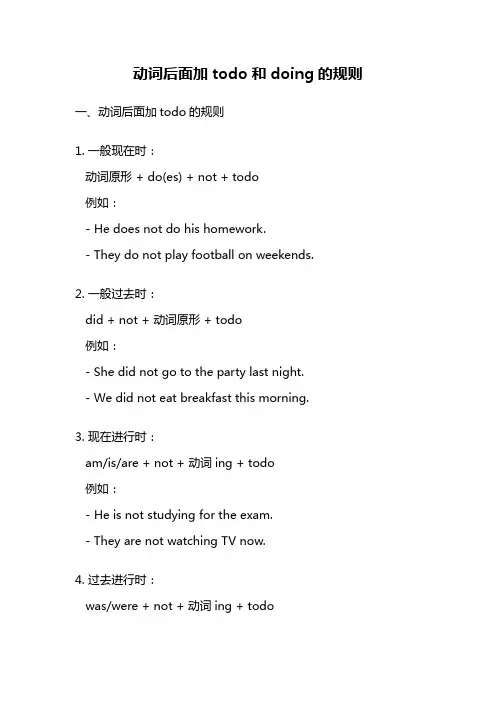
动词后面加todo和doing的规则一、动词后面加todo的规则1. 一般现在时:动词原形 + do(es) + not + todo例如:- He does not do his homework.- They do not play football on weekends.2. 一般过去时:did + not + 动词原形 + todo例如:- She did not go to the party last night.- We did not eat breakfast this morning.3. 现在进行时:am/is/are + not + 动词ing + todo例如:- He is not studying for the exam.- They are not watching TV now.4. 过去进行时:was/were + not + 动词ing + todo- She was not cooking dinner at 7 p.m.- We were not playing basketball yesterday.5. 现在完成时:have/has + not + done + todo例如:- I have not finished my homework yet.- He has not seen the movie.6. 过去完成时:had + not + done + todo例如:- She had not visited her grandparents before. - They had not traveled abroad by then.7. 将来时:will + not + 动词原形 + todo例如:- We will not go to the party tomorrow.- He will not help you with your project.8. 过去将来时:would + not + 动词原形 + todo- She would not come to the meeting if it rains.- They would not buy the car if it is too expensive.二、动词后面加doing的规则1. 一般现在时:动词原形 + do(es) + doing例如:- He does not like doing homework.- They do not enjoy playing football.2. 一般过去时:did + 动词原形 + doing例如:- She did not spend time doing housework yesterday. - We did not spend much time doing exercise last week.3. 现在进行时:am/is/are + 动词ing + doing例如:- He is not studying English now.- They are not watching TV, they are doing homework.4. 过去进行时:was/were + 动词ing + doing例如:- She was not cooking dinner at 7 p.m., she was doing yoga. - We were not playing basketball, we were doing our math homework.5. 现在完成时:have/has + been + 动词ing + doing例如:- I have not been studying for a long time.- He has not been working on the project recently.6. 过去完成时:had + been + 动词ing + doing例如:- She had not been traveling for a month before she got sick.- They had not been practicing the piano for a long time.7. 将来时:will + be + 动词ing + doing例如:- We will not be going on a trip next month.- He will not be attending the conference next week.8. 过去将来时:would + be + 动词ing + doing例如:- She would not be coming to the party if she is busy.- They would not be staying at the hotel if it is not convenient.以上就是动词后面加todo和doing的规则,希望能对你有所帮助。
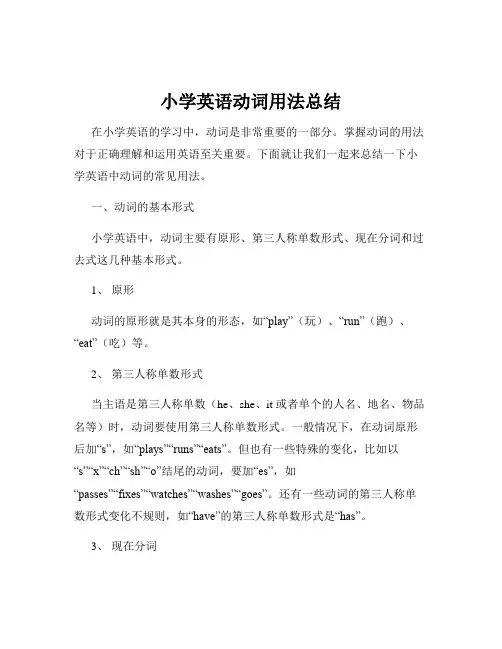
小学英语动词用法总结在小学英语的学习中,动词是非常重要的一部分。
掌握动词的用法对于正确理解和运用英语至关重要。
下面就让我们一起来总结一下小学英语中动词的常见用法。
一、动词的基本形式小学英语中,动词主要有原形、第三人称单数形式、现在分词和过去式这几种基本形式。
1、原形动词的原形就是其本身的形态,如“play”(玩)、“run”(跑)、“eat”(吃)等。
2、第三人称单数形式当主语是第三人称单数(he、she、it 或者单个的人名、地名、物品名等)时,动词要使用第三人称单数形式。
一般情况下,在动词原形后加“s”,如“plays”“runs”“eats”。
但也有一些特殊的变化,比如以“s”“x”“ch”“sh”“o”结尾的动词,要加“es”,如“passes”“fixes”“watches”“washes”“goes”。
还有一些动词的第三人称单数形式变化不规则,如“have”的第三人称单数形式是“has”。
3、现在分词现在分词通常用于进行时态,表示正在进行的动作。
一般在动词原形后加“ing”,如“playing”“running”“eating”。
但也有一些特殊情况,比如以不发音的“e”结尾的动词,要去掉“e”再加“ing”,如“write”的现在分词是“writing”;以重读闭音节结尾且末尾只有一个辅音字母的动词,要双写这个辅音字母再加“ing”,如“swim”的现在分词是“swimming”。
4、过去式过去式用于一般过去时态,表示过去发生的动作。
大部分动词的过去式是在动词原形后加“ed”,如“played”“ran”“ate”。
但也有很多不规则动词,如“go”的过去式是“went”,“see”的过去式是“saw”等。
二、动词的时态1、一般现在时一般现在时表示经常发生的动作或存在的状态。
当主语是第三人称单数时,动词要用第三人称单数形式;其他人称则用动词原形。
例如:“I play football every day”(我每天踢足球。
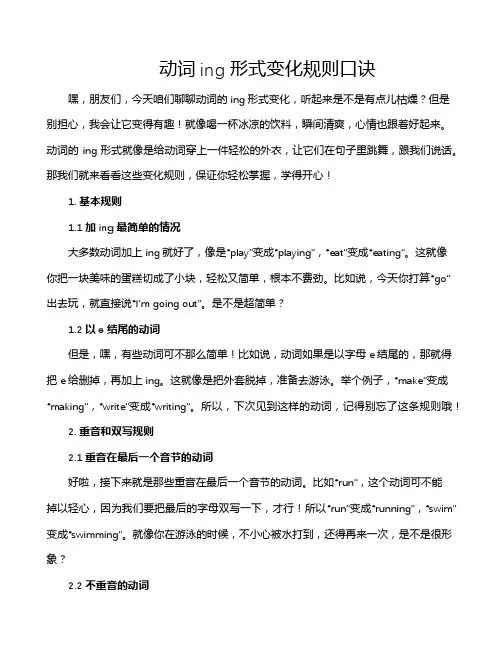
动词ing形式变化规则口诀嘿,朋友们,今天咱们聊聊动词的ing形式变化,听起来是不是有点儿枯燥?但是别担心,我会让它变得有趣!就像喝一杯冰凉的饮料,瞬间清爽,心情也跟着好起来。
动词的ing形式就像是给动词穿上一件轻松的外衣,让它们在句子里跳舞,跟我们说话。
那我们就来看看这些变化规则,保证你轻松掌握,学得开心!1. 基本规则1.1 加ing最简单的情况大多数动词加上ing就好了,像是“play”变成“playing”,“eat”变成“eating”。
这就像你把一块美味的蛋糕切成了小块,轻松又简单,根本不费劲。
比如说,今天你打算“go”出去玩,就直接说“I’m going out”。
是不是超简单?1.2 以e结尾的动词但是,嘿,有些动词可不那么简单!比如说,动词如果是以字母e结尾的,那就得把e给删掉,再加上ing。
这就像是把外套脱掉,准备去游泳。
举个例子,“make”变成“making”,“write”变成“writing”。
所以,下次见到这样的动词,记得别忘了这条规则哦!2. 重音和双写规则2.1 重音在最后一个音节的动词好啦,接下来就是那些重音在最后一个音节的动词。
比如“run”,这个动词可不能掉以轻心,因为我们要把最后的字母双写一下,才行!所以“run”变成“running”,“swim”变成“swimming”。
就像你在游泳的时候,不小心被水打到,还得再来一次,是不是很形象?2.2 不重音的动词不过,有些动词就不需要双写,比如“open”或“visit”。
它们的重音不在最后,所以直接加上ing就好了,像“open”变成“opening”,“visit”变成“visiting”。
这就像是走进一家店,发现这里真不错,直接进去逛逛,轻松自在。
3. 特殊情况3.1 以y结尾的动词接下来我们得聊聊那些以y结尾的动词。
只要y前面不是元音,咱们就可以安心地加上ing,比如“study”变成“studying”。
动词to_do_和_doing总结和口诀动词后加to do 和 doing的记忆口诀一、只能用动名词(ing)作宾语[口诀]考虑建议盼原谅,承认推迟没得想。
避免错过继续练,否定完成停欣赏。
禁止想象才冒险,不禁介意弃逃亡。
consider考虑suggest建议/advocate 提倡主张look forward to 盼望forgive原谅/pardon 原谅acknowledge承认/admit 承认postpone延迟延期/delay 延迟/defer 拖延recall回想/fancy 幻想爱好avoid避免miss错过keep保持practise练习实践deny否认complete完成/finish 完成cease停止/quit 放弃停止appreciate感激欣赏forbid禁止/prevent 阻止imagine设想risk冒险can’t help 不禁mind介意escape逃跑逃避加动名词的动词大集合口诀(原创)故事是以一个家长的口吻讲述:我有时很感激欣赏(appreciate)我的孩子,但总是避免(avoid)承认(admit)这一点,请允许(allow)我寻求您的建议(advise),{名词为advice}您考虑(consider)后告诉我如何克服这个小缺点。
还有一件事,我的孩子总是拖延(delay)他不喜欢(dislike)的事,不可否认(deny)这就是逃避(escape)。
老师原谅(excuse)了他,但是告诫他要喜欢(enjoy)自己的该做的事。
我曾经禁止(forbid)他凭空想象(fancy)赶快完成(finish)自己手头的事,他反对我并保持(keep)他的想象(imagine),说介意(mind)自已会错过(miss)任何灵感。
有专家告诉我要允许(allow)孩子去实践(practise),去冒险(risk),因为孩子不能抵制(resist)自己闯的诱惑,只要建议(suggest)他忍受(stand)住任何学习工作的艰苦就可以了。
动词to do与doing用法区别在英语学习中,动词的 to do 形式和 doing 形式的用法是一个重要且常让人感到困惑的知识点。
理解它们之间的区别对于正确使用英语、表达准确的意思至关重要。
首先,让我们来看看动词不定式 to do 的用法。
动词不定式具有名词、形容词和副词的特征,可以在句子中充当多种成分。
作为主语时,如“To learn English well is not easy”(学好英语不容易。
)此时,它常常表示具体的、一次性的或未来的动作。
作宾语时,常见的动词有 want, hope, decide 等。
例如:“I want to go shopping”(我想去购物。
)这里表达的是一种意愿或计划。
作定语时,它通常放在被修饰词的后面。
比如:“I have a lot of work to do”(我有很多工作要做。
)作状语时,可表示目的、结果等。
“He came here to see me”(他来这儿是为了看我。
)这就是表示目的。
而动词的 ing 形式(doing),也有着丰富的用法。
作主语时,“Reading is a good habit”(阅读是个好习惯。
)它更强调一种一般性、习惯性的动作。
作宾语时,比如 enjoy, finish 等动词后常接 ing 形式。
“I enjoy reading books”(我喜欢读书。
)作定语时,“The swimming pool is very big”(这个游泳池很大。
)作状语时,可以表示时间、原因、伴随等。
“While reading the book, I fell asleep”(在读书的时候,我睡着了。
)在某些动词后,接 to do 和 doing 形式会有不同的含义。
例如,remember to do 表示“记得去做某事(还未做)”,remember doing 表示“记得做过某事”;forget to do 是“忘记去做某事(还未做)”,forget doing 则是“忘记做过某事”。
一、【非谓语动词】:表示动作或者动词词组,不做谓语。
今天主讲非谓语动词形式:to + 动词动词原形 ,动词原形+ing(V-ing)。
1.动词不定式:由to+动词原形构成。
可以做主语,宾语,定语,表语和状语。
(1)做主语To get there by bike will take us an hour.解析:译文:骑自行车到达那里将会需要1个小时。
非谓语动词不定式词组做主语:to get there by bike谓语:will take宾语1:us(直接宾语)宾语2:anhour(间接宾语)(2)做宾语The driver failed to see the car in time.解析:译文:这个司机没有及时看到这个小轿车。
主语:Thedriver谓语:failed宾语:to see the car(非谓语不定式词组做宾语)状语(时间):in time(3)宾补We believe him to be guilty.解析:译文:我们相信他是无罪的。
主语:We谓语:believe宾语:him宾补:to be guilty(对宾语的补充说明)(4) 定语The next train to arrive is from Seoul.解析:译文:马上即将到达的列车是来自首尔的。
主语:The nexttrain谓语:is from宾语:Seoul定语:to arrive(定语是修饰主语的,这里toarrive “即将到达”,修饰 the next train“下一趟列车”)(5) 表语My suggestion is to put off the meeting.解析:译文:我的建议是推迟这次会议。
主语:Mysuggestion谓语:is宾语:the meeting表语:to putoff(主系表,在is后面为表语)(7) 状语I come here only to say goodbye to you.解析:译文:我来到这只想跟你告别。
动词ing形式知识点总结一、动词的ing形式的构成动词的ing形式一般是在动词原形的基础上加上-ing后缀来构成的。
例如:walk → walkingeat → eatingwrite → writing但是也有一些不规则的情况,如:go → goingrun → runningswim → swimming动词的ing形式可以作为动名词使用,表示动作或状态的进行或延续。
它还可以用作动词短语、现在分词或复合动词的一部分,具体用法将在接下来的内容中详细介绍。
二、动词的ing形式在进行时态中的用法1. 表示正在进行的动作动词的ing形式可以用于进行时态,表示正在进行的动作。
例如:He is reading a book.(他正在看书。
)She is writing an article.(她正在写一篇文章。
)They are playing basketball.(他们正在打篮球。
)2. 表示一段时间内延续进行的动作动词的ing形式也可以表示一段时间内延续进行的动作。
例如:I have been studying English for five years.(我已经学习英语五年了。
)She has been working here since last month.(她上个月就在这工作了。
)They have been living in this city for a long time.(他们在这座城市住了很长时间。
)3. 注意事项在进行时态中,be动词的形式(am/is/are)加上动词的ing形式构成句子的谓语部分。
同时,进行时态也对时间状语有一定的限制,表示正在进行的动作必须是在说话时或与说话时有关的时间内进行的。
例如:I am studying English.(表示正在进行的动作)I was studying English when he called.(表示过去正在进行的动作)三、动词的ing形式在现在分词和动词短语中的用法1. 作为现在分词使用动词的ing形式可以作为现在分词使用,充当形容词修饰名词或代词。
动词后接V-ing和todo做宾语的各种情况分类总结动词之后接非谓语动词to do或doing大致可以分四类,一,只接动词不定式to do;二,只接doing;三,既可以接to do也可以接doing 意义基本相同;四,既可以接to do也可以接doing意义截然不同。
这样记忆更方便。
一. 只接不定式的动词1. want to do sth. 想要做某事2. would like /love to do sth.想要做某事3. wish to do sth. 希望做某事4. help to do sth. 帮助做某事5. hope to do sth. 希望做某事6. learn to do sth. 学会做某事7. manage to do sth. 设法做成某事8. offer to do sth. 主动提出做某事9. plan to do sth. 计划做某事10. afford to do sth. 负担得起做某事(时间或金钱方面)11. agree to do sth. 做某事12. arrange to do sth.安排做某事13. ask to do sth. 要求做某事14. beg to do sth. 恳求做某事15. care to do sth. 愿意/喜欢做某事16. choose to do sth. 选择做某事17. decide to do sth. 决定做某事18. demand to do sth. 要求做某事19. determine to do sth. 决心做某事(常有被动式be determined to do sth.)20. expect to do sth. 等待做某事(常有被动式be expected to do sth.)21. fear to do sth. 惧怕做某事22. prepare to do sth. 预备做某事23. pretend to do sth. 伪装做某事(pretend to have done sth.假装做过某事/pretend to bedoing sth.假装正在做某事)24. promise to do sth. 答应做某事25. refuse to do sth. 拒绝做某事二. 只接动名词的动词1. practice doing sth. 练习做某事2. consider doing sth. 考虑做某事3. enjoy doing sth. 喜欢做某事4. finish doing sth. 完成做某事5. give up doing sth. 放弃做某事6. imagine doing sth. 想象做某事7. keep doing sth. 一直做某事8. put off doing sth. 推迟做某事9. risk doing sth. 冒险做事10. suggest doing sth. 建议做某事11. admit doing sth. 承认做某事12. advise doing sth. 建议做某事13. allow doing sth. 允许做某事14. appreciate doing sth. 感谢做某事15. avoid doing sth. 避免做某事16. delay doing sth. 拖延做某事17. deny doing sth. 否认做某事18. discuss doing sth. 讨论做某事19. dislike doing sth. 不喜欢做某事20. escape doing sth. 逃脱做某事21. excuse doing sth. 原谅做某事22. fancy doing sth. 想象/喜爱做某事23. forbid doing sth. 禁止做某事24. mention doing sth. 提及做某事25. mind doing sth. 介意做某事26. miss doing sth. 错过做某事27. permit doing sth. 允许做某事28. prohibit doing sth. 禁止/阻止做某事(=ban doing sth.)三.既可以接不定式也可以接动名词,意义基本相同1,begin doing sth.(开始做某事)begin to do sth.(开始做某事)2,start doing sth.(开始做某事)start to do sth.(开始做某事)3,like doing sth.(喜欢做某事)like to do sth.(喜欢做某事)4,dislike doing sth.(不喜欢做某事)dislike to do sth.(不喜欢做某事)四. 既可接不定式也可接动名词,意义截然不同1. remember to do sth. 记住要做某事(未做)remember doing sth. 记得做过某事(已做)2. forget to do sth. 忘记去做某事(未做)forget doing sth. 忘记做过某事(已做)3. regret to do sth. 遗憾要做某事(未做)regret doing sth. 后悔/抱歉做过某事(已做)4. try to do sth. 努力做某事try doing sth. 尝试做某事5. mean to do sth. 计划做某事mean doing sth. 意味着做某事6. can’t help to do sth. 不能帮助做某事can’t help doing sth. 情不自禁做某事7. go on to do sth. 继续做另一件事go on doing sth. 继续做同一件事8. stop to do sth. 停下来去做另一件事stop doing sth. 停下正在做的事情四,感官动词接动词原形do或现在分词V-ing做宾语补语,意义有别,前者表示动作结束,后者表示动作在进行中1. see sb. do sth. 看到某人做过了某事see sb.doing sth.看见某人正在做某事2. watch sb. do sth. 观看某人做了某事watch sb. doing dth.观看某人在做某事3. notice sb. do sth. 注意到某人做了某事notice sb. doing sth.注意到某人在做某事4. observe sb. do sth. 观察到某人做了某事observe sb. doing sth.观察某人在做某事5, hear sb. do sth. 听到某人做了某事hear sb. doing sth.听见某人在做某事6,feel sb. do sth.(感觉某人做过某事)feel sb. doing sth.(感觉某人正在做某事)五,表示“使或让”三个动词后接省略to的不定式一个动词接to do1. make sb. do sth. 使某人做某事2. let sb. do sth. 让某人做某事3. have sb. do sth. 使某人做某事4.get sb. to do sth.让某人做某事注意:以上感官动词用法灵活,它可以接省去to的不定式即动词原形做宾补也可以接现在分词和过去分词作宾补,但在表达的时间和语态上会有变化,我们以see为例来区分一下。
小学英语动词to do、动词ing和动词原形的用法总结
运用技巧
动词to do(不定式)、动词ing(动名词)以及动词原形这三种动词形态是小学英语考试的一个重难点,也是困扰很多学生的一个难题,下面讲解下这三种基本动词形态的区别。
一、动词原形怎么用?
1、语法层面。
一般现在时中,主语非第三人称单数,其后的动词用原形。
如:
We all like learning English.(we不是第三人称单数,其后like用原形)
2、句式层面。
祈使句(表达命令、要求、劝告、警告、禁止等的句子)开头的动词用原形。
如下2例:
(1)Be quiet!all of you.(你们所有人都要保持安静!)
(2)Don't do your homework late at night! or you will be late for school tomorrow. (晚上不要做你的家庭作业太晚,否则你明天将会上学迟到)
3、用词搭配层面。
分几种情况:
(1)情态动词。
如can/could/should/must/will等后面动词用原形。
例:
Daniel can play basketball well.(情态动词can紧随其后的动词用原形)
(2)固定搭配。
let sb do sth./make sb do sth./ help sb do sth.
例:Let's have some fun!(让我们玩的开心)
(3)助动词。
如do/does/did以及它们的否定形式,后面跟动词原形。
例:Does she read newspapers?(does后紧随其后的动词用原形)
(4)why not do sth.为什么不做某事
例:Why not sing a song?(为什么不唱首歌呢?)
二、动词to do怎么用?
1、语法层面。
动词to do 形式表目的,意为“为了……/去干……”,放在句首的时候表达“为了”,放在句中或句末时表达“去干”,下面举3个例子说明:
例1:To keep safe, you shouldn't run on the road.(为了保持安全,你不应该在路上跑)
例2:What should you do to cross the road safely?(你应该做什么去安全地穿过马路?)
例3:Beijing is a beautiful place to travel.(北京是一个去旅游的好地方)
2、句式层面。
It' s time (for sb) to do sth./ It' s +形容词+(for sb)+ to do sth
例1:It' s time to have class.(该上课了)
例2:It' s easy for me to drive.(对我来说,开车很容易)
3、用词搭配层面。
(1)want to do / would like to do想要干某事
(2)ask sb to do / tell sb to do/invite sb to do叫/告诉/邀请某人做某事
(3)plan to do 计划做某事
(4)have to do不得不做某事
(5)use sth. to do 用……去干……
(6)be ready to do sth.准备好干某事
(7)can't wait to do sth.迫不及待去做某事
三、动词ing怎么用?
1、语法层面。
表达正在进行时态,be动词+动词ing结构。
例:He is playing the piano now.(他现在正在弹钢琴)
2、句式层面。
动词ing开头充当名词作句子的主语。
看2个例子:
例1:Swimming is good for your health.(游泳对你的身体好)
例2:Smoking too much is bad for you.(吸烟太多对你不好)
3、用词搭配层面。
(1) 固定搭配。
like/love +doing喜爱干某事;finish doing完成干某事;keep doing 继续干某事
(2) 表示课程。
Swimming/Dancing/ lesson
例:I am going to have a Dancing lesson this weekend.
(3) 表示标志。
No Parking/ No Smoking
(4) 用在介词后面。
be good at/ what about/how about+doing
例:What about having a picnic?
(5)go+动词ing,表达“去干什么”go fishing/swimming/shopping...例:Let's go fishing.
(6)be busy doing sth.忙于做某事
例:She is busy with her homework.
(7)thank sb for doing sth.感谢某人做某事
例:Thank you for helping me.。